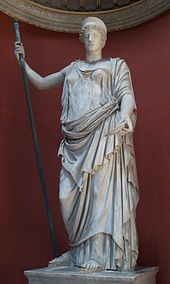Leonardo Agostini
Leonardo Agostini (* 1594 in Boccheggiano (today to Montieri ), † August 1676 in Rome ) was an Italian antiquarian . He is considered to be one of the most important " antiquarians " of his time and made a name for himself in researching antique gems . Agostini was 1655-1670 papal antiquarian and overseer of the collections of antiquities and excavations of the Papal States ( Commissario delle Antichità ).

Life
Leonardo Agostini's biography is only partially tangible before he moved to Rome. He studied at the University of Siena and then went to Florence , where he was under the patronage of the Medici . From Florence he went to Rome, where he supplied Cardinal Francesco Barberini with antique statues and building materials for the renovated Palazzo Barberini from the beginning of the 1630s . At the intercession of Cassiano Dal Pozzo , Agostini was entrusted by Cardinal Barberini in 1639 with looking after the collection of coins and antiquities. In 1649 he published his first book, Filippo Parutas, on the ancient coins of Sicily, which was first published in 1612, in a revised form that has been greatly expanded to include 400 coins. From around 1650 he reported regularly to Leopoldo de 'Medici about new archaeological finds and also conveyed antiquities to him. Pope Alexander VII appointed him to succeed Niccolò Menghini as Commissario delle Antichità , and in 1670 Giovanni Pietro Bellori succeeded him in this important office. In this function, he commissioned excavations as the superintendent of the ancient monuments and the papal collections of the city and issued permits to private individuals. He also guided prominent visitors to Rome through the ancient city. He also carried out his own excavations, of particular importance were the excavations on the Forum and in 1657 on the Caelius . During the excavations in the thermal baths near the church of San Lorenzo in Panisperna , he discovered the Hera Barberini . Agostini was very knowledgeable about the antiques market, was well informed about the value of collections, for example, but was also well informed about new finds of antiquities. As a court antiquarian, he also had a trained eye for distinguishing between ancient and modern gems and coins. Agostini himself put together a large library as well as a private collection of gems, coins, bronzes and marble busts. After his death some of them ended up in the collection of Cosimo III. de 'Medici , part of the gem collection is now in the National Archaeological Museum in Florence .
Agostini's main work is the antichi figurate , to which Giovanni Battista Galestruzzi contributed pictures. Here he not only presented the gems, as usual, with an explanation of the picture, but was also the first researcher to specify the material from which the pieces were made. In addition, there are further explanations by Giovanni Pietro Bellori, Agostini placed great confidence in his future successor. The first volume contained pieces from the Barberini collection, which were arranged thematically, the second volume contained pieces from Rome without a thematic structure. Despite his expertise in questions of the authenticity of gems, he was more interested in the motif, which is why he included pieces from the Renaissance and modern times in his works in addition to ancient, especially Roman gems . The work was still frequently reprinted or reprinted after Agostini's death, around 1686 by Pietro Santi Bartoli , and had a long lasting effect. In 1685 Jakob Gronovius published a Latin translation in Amsterdam . Agostini recognized the importance of ancient remains, especially the gems, as models for contemporary artists. He was personally acquainted with many researchers and artists; in addition to those already mentioned, he also knew Andrea Sacchi, for example . He also owned a cartoon by Annibale Carracci .
literature
- Raffaello Barabesi: L'antiquario Leonardo Agostini e la sua terra di Boccheggiano . In: Marenima 3, 1926-27, pp. 149-189.
- Agostini, Leonardo. In: Alberto M. Ghisalberti (Ed.): Dizionario Biografico degli Italiani (DBI). Volume 1: Aaron – Albertucci. Istituto della Enciclopedia Italiana, Rome 1960, pp. 464-465.
- Elena Vaiani: La collezione d'arte e antichità di Leonardo Agostini. Nuovi Documenti . In: Elena Vaiani (ed.): Dell'antiquaria e dei suoi metod. Atti delle giornate di studio, Pisa 1998 (Pisa 2001) pp. 81-110.
- Jörn Lang: Agostini, Leonardo. In: Peter Kuhlmann , Helmuth Schneider (Hrsg.): History of the ancient sciences. Biographical Lexicon (= The New Pauly . Supplements. Volume 6). Metzler, Stuttgart / Weimar 2012, ISBN 978-3-476-02033-8 , column 6 f.
Web links
- Agostini in the Dictionary of Art Historians
- Publications by Leonardo Agostini in the Opac des Servizio Bibliotecario Nazionale
- Standard entry in the Opac of the Servizio Bibliotecario Nazionale
Remarks
- ↑ 20 sample pages on the Internet Culturale.
- ^ Title page and three other page examples on the Internet Culturale. Another edition was published by Marco Maier in Lyon in 1697: sample pages on the Internet Culturale, all of them from Heidelberg historical holdings - digital.
| personal data | |
|---|---|
| SURNAME | Agostini, Leonardo |
| BRIEF DESCRIPTION | Italian antiquarian |
| DATE OF BIRTH | 1594 |
| PLACE OF BIRTH | Boccheggiano |
| DATE OF DEATH | August 1676 |
| Place of death | Rome |